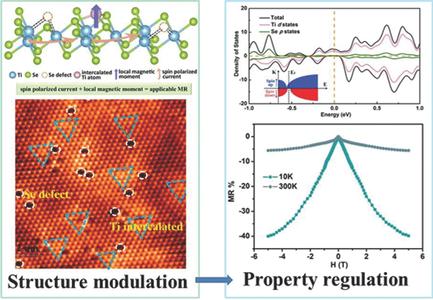当前位置:
X-MOL 学术
›
Adv. Mater.
›
论文详情
Our official English website, www.x-mol.net, welcomes your feedback! (Note: you will need to create a separate account there.)
Half‐Metallic Behavior in 2D Transition Metal Dichalcogenides Nanosheets by Dual‐Native‐Defects Engineering
Advanced Materials ( IF 29.4 ) Pub Date : 2017-09-01 , DOI: 10.1002/adma.201703123 Yun Tong 1 , Yuqiao Guo 1 , Kejun Mu 1 , Huan Shan 1 , Jun Dai 2 , Yi Liu 3 , Zhe Sun 3 , Aidi Zhao 1 , Xiao Cheng Zeng 2 , Changzheng Wu 1 , Yi Xie 1
Advanced Materials ( IF 29.4 ) Pub Date : 2017-09-01 , DOI: 10.1002/adma.201703123 Yun Tong 1 , Yuqiao Guo 1 , Kejun Mu 1 , Huan Shan 1 , Jun Dai 2 , Yi Liu 3 , Zhe Sun 3 , Aidi Zhao 1 , Xiao Cheng Zeng 2 , Changzheng Wu 1 , Yi Xie 1
Affiliation

|
Two‐dimensional transition metal dichalcogenides (TMDs) have been regarded as one of the best nonartificial low‐dimensional building blocks for developing spintronic nanodevices. However, the lack of spin polarization in the vicinity of the Fermi surface and local magnetic moment in pristine TMDs has greatly hampered the exploitation of magnetotransport properties. Herein, a half‐metallic structure of TMDs is successfully developed by a simple chemical defect‐engineering strategy. Dual native defects decorate titanium diselenides with the coexistence of metal‐Ti‐atom incorporation and Se‐anion defects, resulting in a high‐spin‐polarized current and local magnetic moment of 2D Ti‐based TMDs toward half‐metallic room‐temperature ferromagnetism character. Arising from spin‐polarization transport, the as‐obtained T‐TiSe1.8 nanosheets exhibit a large negative magnetoresistance phenomenon with a value of −40% (5T, 10 K), representing one of the highest negative magnetoresistance effects among TMDs. It is anticipated that this dual regulation strategy will be a powerful tool for optimizing the intrinsic physical properties of TMD systems.
中文翻译:

双原生缺陷工程在二维过渡金属双硫属化物纳米片中的半金属行为
二维过渡金属二卤化物(TMD)被认为是开发自旋电子纳米器件的最佳非人为低维构建基块之一。但是,在原始的TMD中,费米表面附近缺乏自旋极化和局部磁矩,极大地阻碍了磁传输特性的开发。在此,通过简单的化学缺陷工程策略成功开发了TMD的半金属结构。双重天然缺陷将二硒化钛与金属-钛原子结合和硒阴离子缺陷并存,从而导致高自旋极化电流和2D Ti基TMD朝向半金属室温铁磁特性的局部磁矩。 。由于自旋极化传输而产生的T-TiSe 1.8纳米片表现出较大的负磁阻现象,值为-40%(5T,10 K),代表了TMD中最高的负磁阻效应之一。可以预料,这种双重调节策略将成为优化TMD系统固有物理特性的有力工具。
更新日期:2017-09-01
中文翻译:

双原生缺陷工程在二维过渡金属双硫属化物纳米片中的半金属行为
二维过渡金属二卤化物(TMD)被认为是开发自旋电子纳米器件的最佳非人为低维构建基块之一。但是,在原始的TMD中,费米表面附近缺乏自旋极化和局部磁矩,极大地阻碍了磁传输特性的开发。在此,通过简单的化学缺陷工程策略成功开发了TMD的半金属结构。双重天然缺陷将二硒化钛与金属-钛原子结合和硒阴离子缺陷并存,从而导致高自旋极化电流和2D Ti基TMD朝向半金属室温铁磁特性的局部磁矩。 。由于自旋极化传输而产生的T-TiSe 1.8纳米片表现出较大的负磁阻现象,值为-40%(5T,10 K),代表了TMD中最高的负磁阻效应之一。可以预料,这种双重调节策略将成为优化TMD系统固有物理特性的有力工具。


























 京公网安备 11010802027423号
京公网安备 11010802027423号